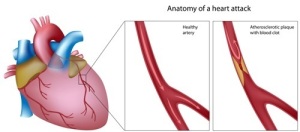Introduction
Coronary heart disease describes changes in the walls of the coronary arteries hat are the blood supply for the heart muscle.
Since the Framingham Heart Study in the U.S. where a population of a whole town has been followed for a period of over 50 years and more, we know that there are a number of risk factors that determine whether we live longer or shorter lives.
All of the factors that play a role have been combined in the Framingham score.
The Framingham score determines the risk of getting a heart attack or dying from a heart attack within 10 years. A score of less than 10 means you have a lower than 10% chance, an intermediate score of 10 to 20 means there is a risk of 10 to 20 % chance of dying from a heart attack within 10 years from now. Finally, a risk of more than 20% is a high risk. Here is a Framingham risk calculator.
High cholesterol, smoking, high blood pressure, age, sex and other factors determine how fast our arteries get clogged up with deposits from inside. The blood supply to the heart muscle consists of three little blood vessels that span around the heart muscle.
The side branches supply each muscle fiber with nutrients and oxygen. Without the constant flow that supplies the heart muscle it could not beat day in and day out. As we age there are changes of the wall of the coronary arteries. Fatty deposits inside the lumen of the coronary arteries are clamping down on the blood supply to the heart (arteriosclerosis) and this can lead to heart attacks, angina and congestive heart failure.
Prevention of coronary heart disease
As already mentioned in the page on hardening of the arteries (see “Arteriosclerosis” under Related Topics below) the major factors that contribute to hardening of the arteries and thus premature aging are smoking, obesity and lack of exercise. All of these factors are reversible. Self hypnosis cassettes can be very useful in combination with the change of these lifestyle factors. This is a powerful preventative step and prevention on the long term is much more powerful than the curative approaches described below. Having said that, do not hesitate to seek prompt advice from your treating physician or the Emergency Department of the nearest hospital when acute disease strikes. The newest findings are that nitric oxide (=NO) (thanks to nature.com/nrd for this link) is necessary to prevent hardening of the arteries, prevent heart attacks, strokes, high blood pressure and Alzheimer’s. NO is being taken into our bodies from green leaved vegetables like kale, Swiss chard, spinach, chicory, arugula, bok choy, beets, lettuce, cabbage etc. Exercise also produces NO (which is a gas) directly from the cells that are lining the arteries. Read more about it in Ref. 6.
References:
1. The Merck Manual, 7th edition, by M. H. Beers et al., Whitehouse Station, N.J., 1999. Chapters 197, 202, 205 and 207.
2. Braunwald: Heart Disease: A Textbook of Cardiovascular Medicine, 6th ed., 2001, W. B. Saunders Co.
3. D C Bauer: Audio-Digest Family Practice Vol. 49, Iss. 09, March 2, 2001.
4. Ferri: Ferri’s Clinical Advisor: Instant Diagnosis and Treatment, 2004 ed., Copyright © 2004 Mosby, Inc.
5. Rakel: Conn’s Current Therapy 2004, 56th ed., Copyright © 2004 Elsevier
6. Nathan S. Bryan, PHD and Janet Zand, OMD: “The nitric oxide (NO) solution. How to boost the body’s miracle molecule to prevent and reverse chronic disease”. Neogenis, published 2010.







